Market Power 2.11-2.12
1/107
Earn XP
Description and Tags
Name | Mastery | Learn | Test | Matching | Spaced |
|---|
No study sessions yet.
108 Terms
There are 4 different types of competiton
perfect competition
monopolistic competition
oligopoly
monopoly
the types of competition are classified by four different criteria
number of firms
freedom of entry to industry
nature of the product
nature of the demand curve
perfect competition has
very many firms
monopolistic competition has
many firms
oligopolies have
few firms
monopolies have
only one firm
perfect competitions freedom of entry is
completely unrestricted
monopolistic competitions freedom of entry is
unrestricted
oligopolies freedom of entry is
restricted
monopolies freedom of entry is
restricted of completely blocked
perfect competitions nature of product are
homogenous (undifferentiated)
monopolistic competitions nature of product are
differentiated
oligopolies nature of product are
undifferentiated or differentiated
monopolies nature of product are
unique
the short run is when the
Time period in which at least one factor of production is fixed and cannot be changed by firm (usually land or capital, not labor)
All production takes place in the short run
Length of short run determined by time it takes to increase the quantity of the fixed factor or production
E.g., If it takes a landscaping company one week to get a new lawnmower, the short run is one week; if it takes two years to build a factory, the short run is two years
the long run is when the
Time period in which all factors of production can be changed
All planning takes place in the long run
No fixed costs, as the whole scale of the operation can change
production output is measured through three values
Total product (TP) = total output a firm produces in a given time period
Can only be increased by adding more units of variable factors (machine operators) to fixed factors
Average product (AP) = output produced on average by each unit of the variable factor
Calculated by dividing TP by number of units of variable factors: AP = TP/V
Marginal product (MP) = extra output produced by using an extra unit of the variable factor
Calculated by dividing change in TP by change in V: MP = ΔTP/ΔV
Law of Diminishing Marginal Returns:
As more and units of a variable factor are added to a given quantity of a fixed factor, output will eventually diminish
the law of diminishing marginal returns can be reversed by
increasing the quantity of the fixed factor
this applies to both cost and output
the different types of total costs are
Total fixed cost (TFC) = total cost of the fixed assets that a firm uses in a given time period
Because number of assets is fixed, TFC is a constant amount
TFC is the same whether the firm produces or not
Example: rent for land/building, base utility bills, insurance, healthcare, etc.
Total variable cost (TVC) = total cost of variable assets a firm uses in a given period of time
TVC increases as the firm uses more of the variable factor
TVC is equal to the number of variable factors times the cost of the variable factor
Example: labor, raw materials for production, etc.
total cost (TC) = total cost of all fixed and variable factors used to produce a certain output
the different types of average/marginal costs are
Average fixed cost (AFC) = fixed cost per unit of output
Calculated by dividing TFC by amount of output (q): AFC = TFC/q
Because TFC is always constant, AFC always falls as output increases
Example: If TFC = $400, then producing 10 units results in an ATC of $40 ($400/10); if 25 units are produced, AFC = $16 ($400/25)
Average variable cost (AVC) = variable cost per unit of output
Calculated by dividing TVC by amount of output (q): AVC = TVC/q
AVC falls as output increases, then starts to rise again as output continues to increase
Average total cost (ATC) = total cost per unit of output
ATC = AFC + AVC or TC divided by amount of output: ATC = TC/q
Also tends to fall as output increases, and then starts to rise again as output continues to increase
Marginal cost (MC) = increase in the total cost of producing an extra unit of output
MC = ΔTC divided by change in amount of output (q): MC = ΔTC/Δq
Again, MC falls as output increases, then starts to rise again as output continues to increase
there are 4 short run cost curves
MC curve
ATC curve
AVC curve
AFC curve
the MC curve will always cut the
AVC and ATC curves at their lowest point
once MC = AC, the increasing MC starts to increase
average costs
where the MC curve intersects the AC curve producers are
producing at the lowest possible cost
therefore productive efficiency is achieved where MC = AC
if firms want to producer more in the long run
they must lower their costs by altering the factors of production
the long run average cost curve (LRAC) is also known as an
“envelope curve” because it envelops an infinite number of short run average cost (SRAC) curves
LRAC curve represents the boundary between
attainable and unattainable unit cost levels of a firm
Scale =
a proportion or relative level of size or degree
the LRAC curve represents
increasing, constant, or decreasing returns of scale
increasing returns to scale means
increase in factors of production leads to greater increase in output and lower long run costs.
decreasing returns to scale means
increase in factors of production leads to smaller increase in output and higher long run costs.
economies of scale =
any decreases in LRAC that result from a firm altering all factors of production in order to increase its scale of output
resulting in increasing returns to scale for the firm
firms achieve economies of scale through 7 methods
specialization
division of labor
bulk buying
financial economies
transport economies
large machinery
promotional economies
specialization occurs when
specialization of labor leads to more efficiency and lower unit costs (e.g., specialized management roles vs. one manager taking on many different roles)
division of labor is when
Breaking down production processes into smaller parts to increase efficiency (e.g., assembly line production)
bulk buying provides
Discounts on larger supplies of raw materials (reduced production costs)
financial economies makes it
Easier for large firms to raise money (more investment for firm, less risk for lenders)
transport economies are when
Larger firms buying in bulk may pay less in transport costs, or may have their own transport fleet (e.g., Amazon)
large machinery means that
Some machinery is too big for small producers; larger firms need larger machinery (e.g., combine harvesters)
promotional economies occur
As a firm increases its output and revenue, expenditure on advertising/publicity remains constant (and therefore falls as the firm grows)
Diseconomies of scale =
any increases in LRAC that result from a firm altering all factors of production in order to increase its scale of output
Results in decreasing returns to scale for the firm
Essentially the long-run version of law of diminishing returns
there are 4 causes for diseconomies of scale
control/communication problems
alienation/loss of identity
slow decision making
excessive bureaucracy
Control/communication problems occur when
Larger firms are more difficult to control, and there is less communication, resulting in lost efficiency
Alienation/loss of identity:
Workers/managers lose sense of purpose/connection to firm, resulting in lost productivity
Revenue =
payments firms receive when they sell their products, goods, or services over a certain period of time
there are three types of revenue
Total revenue (TR) = total amount of money a firm receives by selling a product
TR = p x q
Average revenue (AR) = revenue a firm receives per unit of its sales (same as p)
AR = TR/q = (p x q)/q = p
Marginal revenue (MR) = extra revenue gained by a firm by selling one more unit of a product in a given time period
MR = ΔTR/Δ
if firms do not have to lower prices to sell more of a product the demand curve is
perfectly elastic and total revenue (TR) increase at a constant rate
If demand is perfectly elastic, then price, average revenue, marginal revenue, and demand are all the same
Revenue when the price falls as output increases, the demand curve is
downward sloping
In order to sell more output because of increased demand
firms must lower the price
Because AR = P, it falls as
output increases; therefore, D = AR
MR also falls as
output increases, but at a higher rate; in order to sell more products, the firm must lower the price of all products sold, and thus loses revenue on the ones that could have been sold at a higher price in order to get revenue from the extra sales
TR rises at first, but will eventually start to fall as
output increases. This occurs when MR turns negative.
economic profit are measured in three ways
Normal Profit: total revenue is equal to total cost (zero economic profit)
Abnormal profit: total revenue is greater than total cost (economic profit)
Losses: total revenue is less than total cost (negative economic profit)
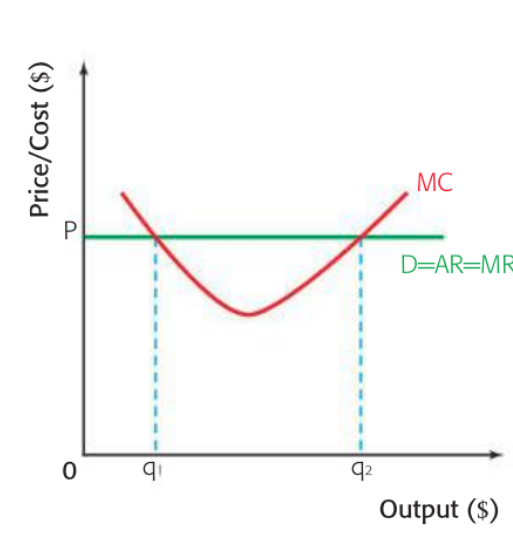
Firms seek to maximize profit. Therefore, if a firm finds that MR > MC,
it should increase production at MC = MR,q₁, profits are minimized
From q₁-q₂, the firm makes a profit on every additional unit produced
After MC = MR, q₂, the firm will make a loss for each additional unit. Therefore, profits are maximized at q₂.
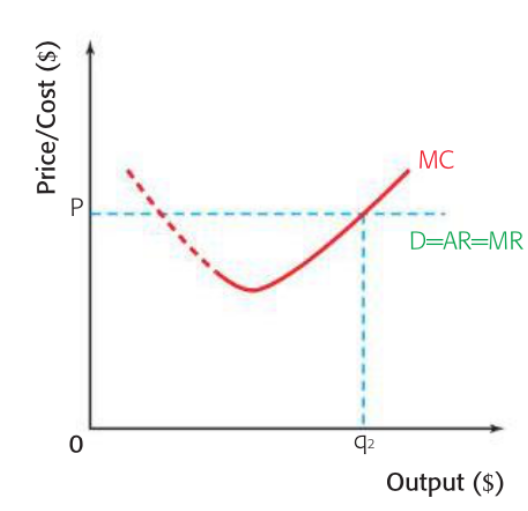
As a rule, firms should produce at the level where
MC cuts MR from below in order to maximize profits
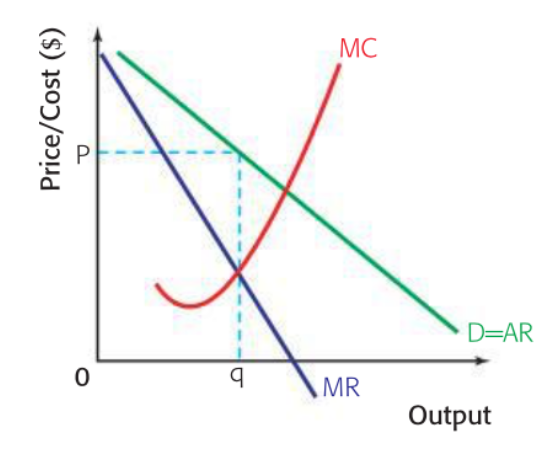
Profit is maximized where
MC = MR, with output at q
P (what consumers are willing to pay for this quantity) is identified where q meets D
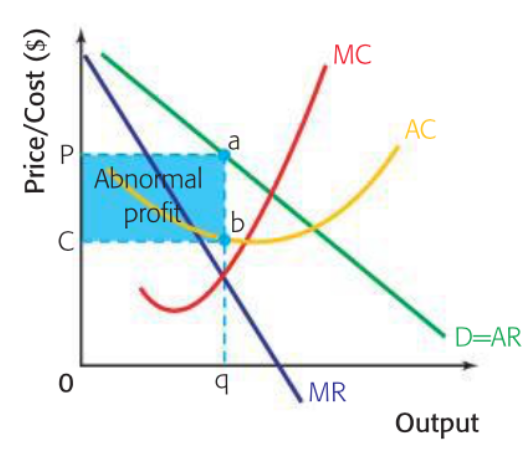
Remember, the MC curve always cuts
the AC curve at its lowest point
The profit of producing q units is the difference between AR and AC
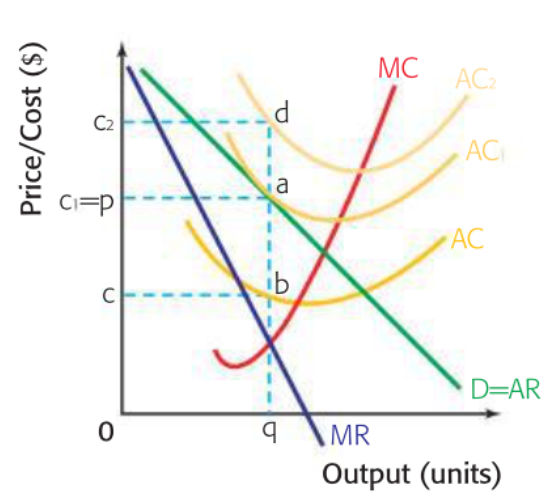
The AC curve is important because its position can show
different profit and loss situations. Here:
AC represents abnormal profit (pabc)
AC₁ represents normal profit (AC = AR)
AC₂ represents losses (pc₂da)
Remember, in a perfectly competitive market:
Because each firm is small compared to the size of the industry,
they cannot affect prices -- they are price takers
Producers and consumers have
perfect knowledge of the market (prices, costs, quality, availability, etc.)
perfect competition cannot have
long run abnormal profits or losses
Perfect competition is theoretical, but some industries are close to being perfectly competitive, such as
those for agricultural goods (e.g., a wet market)
for perfect competition when graphing a firm
the demand curve will be perfectly elastic (because they are price takers).
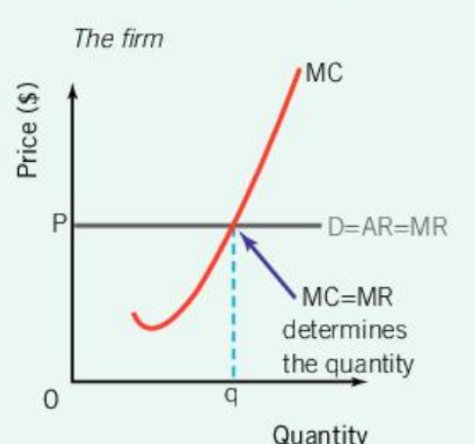
Perfect Competition: Profits and Losses (Short Run)
firms maximize profits when they produce at the level of output where
MC = MR; this will always identify the quantity (q)
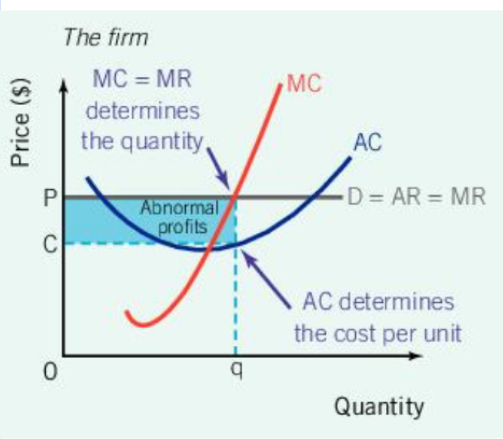
Perfect Competition: Profits and Losses (Short Run) (Abnormal Profit)
Now we add the average cost (AC) curve
In this case, the cost per unit, or average cost, (C) is
less than the industry price (P) and average revenue
Therefore, the firm makes an abnormal profit of P-C, or, the area shaded in blue
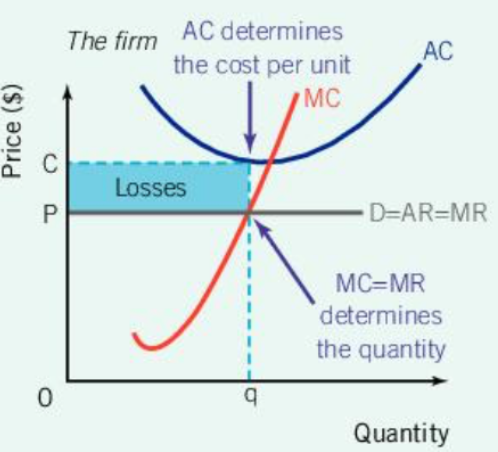
Perfect Competition: Profits and Losses (Short Run) (losses)
Here, cost per unit (C) is
greater than the industry price (P) and average revenue, resulting in losses for the firm
Because producing at any other level of output would result in further losses, the firm is still producing at the profit maximizing level of output--they are loss minimizing
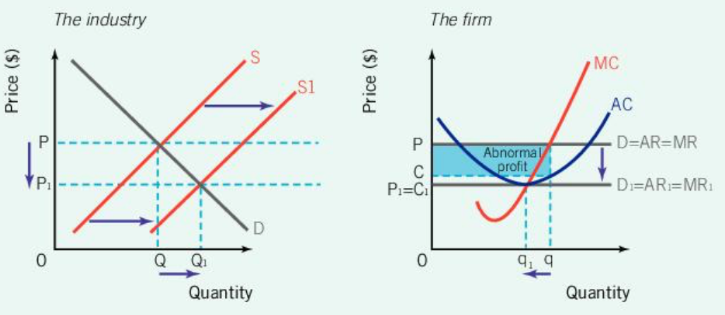
Perfect Competition: Profits and Losses (Long Run) (short run abnormal profits to long run normal profits)
More firms enter the industry because
of abnormal profits (perfect knowledge and no barriers)
Over time, the supply curve shifts to the right, increasing total industry quantity (Q) and lowering prices (P)
Firms start to make normal profits, and no more firms enter the industry. The industry is bigger and produces more in total (Q1), with more, smaller firms producing less per firm (q1)
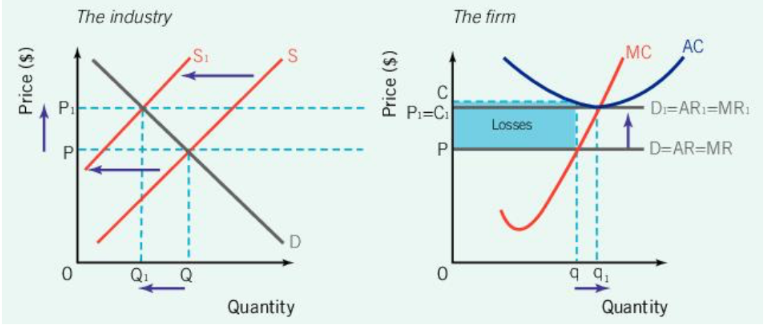
Perfect Competition: Profits and Losses (Long Run) (Short-run losses to long-run normal profits)
Firms exit the market because of
losses
The supply curve shifts to the left, decreasing total industry quantity (Q) and increasing prices (P)
Losses are reduced and firms start to make normal profits. The industry is smaller and produces less in total (Q1), with fewer, larger firms producing more per firm (q1)
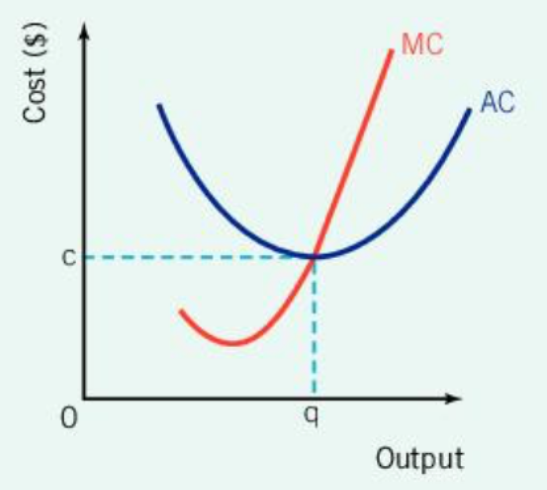
Perfect Competition: Efficiency
Productive efficiency:
producing goods and services with the optimal combination of inputs to produce maximum output for the minimum cost
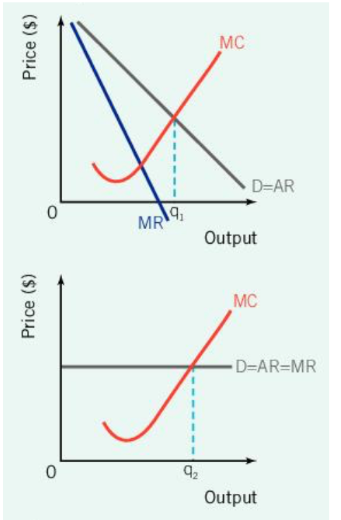
Perfect Competition: Efficiency
Allocative efficiency:
optimal distribution of goods and services, taking into account consumer preferences
Occurs where Price equals the Marginal Cost (MC) of production
This is because the price that consumers are willing to pay is equivalent to the marginal utility that they get, thus the optimal distribution is achieved when the marginal utility of the good equals the marginal cost.
Therefore, allocative efficiency is where MC = AR
Monopolistic Competition cannot have
long run abnormal profits or losses
in monopolistic competition product differentiation allows
consumer preference and therefore, brand loyalty
Because of brand loyalty, firms can be price makers to some extent
This ability to make prices gives them some market power, but it is small because the firm is small relative to the size of the industry (e.g., Nike in the shoe industry)
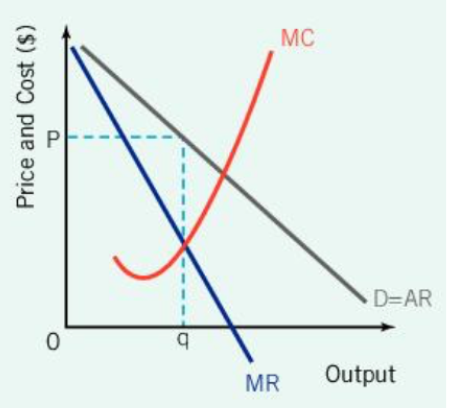
Monopolistic Competition
Because firms are price makers to some extent, this will result in
a downward sloping and relatively elastic demand curve
Remember, the firm maximizes profits by producing at q, where MC = MR
At this level of output, price is at level P
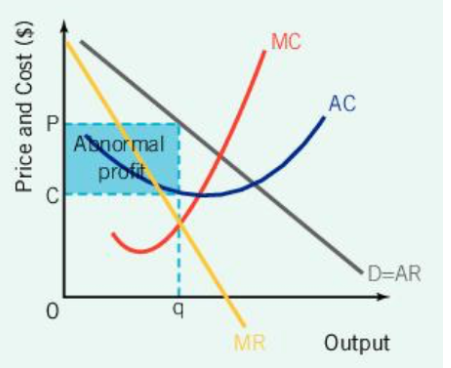
Monopolistic Competition: Profits and Losses
Short run abnormal profit
The per unit cost (C) is
below the selling price (P)
This results in abnormal profits and firms will begin to enter the industry
How efficient is this situation in terms of
Productive efficiency (lowest cost per unit, or, MC = AC)?
Allocative efficiency (socially optimal level of output, or, MC = AR)?
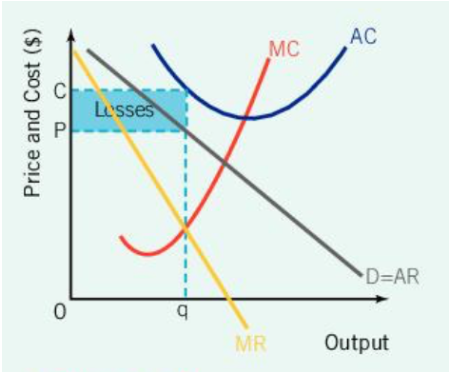
Monopolistic Competition: Profits and Losses
Short run losses
The per unit cost (C) is
higher than the selling price (P)
This results in losses; firms will begin to exit the industry
How efficient is this situation in terms of
Productive efficiency (lowest cost per unit, or, MC = AC)?
Allocative efficiency (socially optimal level of output, or, MC = AR)?
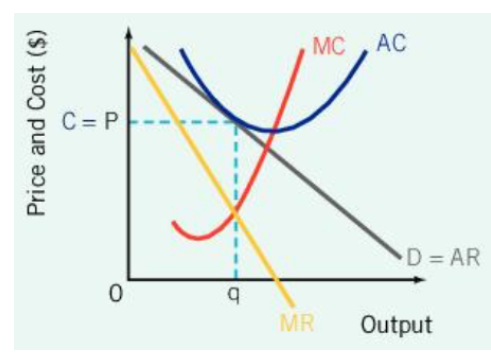
Monopolistic Competition: Profits and Losses
long run normal profit
Profit is maximized (MC = MR)
Cost per unit (C) equals
price per unit P (or, AC = AR); each firm is covering its costs
No firms will enter or exit the industry, because neither losses nor abnormal profits are being made
What about efficiency?
This scenario is not productively efficient (MC ≠ AC at q)
It is also not allocatively efficient (MC ≠ AR at q)
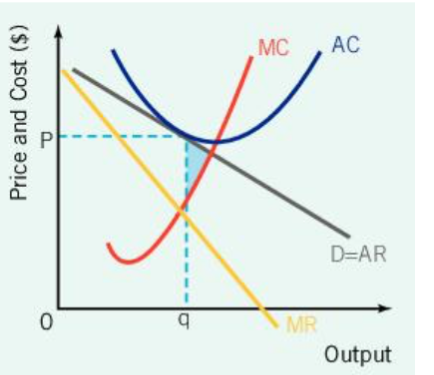
Monopolistic Competition: Market Failure?
Lack of allocative efficiency =
market failure
The lack of efficiency is offset by the presence of greater product variety (i.e., consumers give up efficiency, but they get greater product choice)
monopolistic competition is good because of
Strong competition makes “price exploitation” lower than monopoly/oligopoly
Differentiated goods means plenty of substitutes available
Differentiation makes it difficult to exploit economies of scale (and therefore obtain significant market power)
is government intervention necessary for monopolistic competition
Only to fix the negative effects of imperfect information: trade standards, licensing, nutrition facts, health inspections, etc.
because of barriers to entry for a monopoly
the monopoly can make abnormal profits in the long run
The best way to define a monopoly is
how much market power it has: to what extent can the firm set its own prices without worrying about competitors and keep others out of the industry?
How can a monopoly maintain its position (ie., What are the barriers to entry)
monopolies have
economies of scale
Natural monopoly
The most efficient number of firms is one; the fixed costs are so high that it is impractical to have more than one firm producing
Example: Tap water. Because setting up the system of pipes and sewers is so expensive, it wouldn’t make sense to have two water companies.
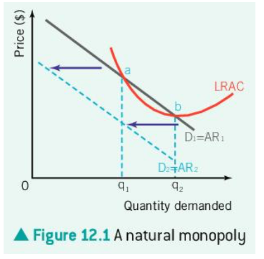
this is the scenario where another firm joins a natural monopoly, if this happens
the natural monopoly would make abnormal profit between q1 and q2; if the new firm entered the industry, then demand would be taken from the monopoly, shifting the curve to the left and therefore making it impossible to make a profit
How can a monopoly maintain its position (ie., What are the barriers to entry)?
Legal barriers
Firms may be given the legal right to exclusive production
Examples include patents, copyrights, trademarks, or a nationalized industry
E.g., a pharmaceutical company gets a patent for a drug it develops, meaning only they can produce it
How can a monopoly maintain its position (ie., What are the barriers to entry)?
Brand loyalty
If a product gains enough brand loyalty, other firms may be discouraged from entering the industry because they feel they may not be able to compete
E.g., Hoover vacuum cleaners--now in some places “hoover” means a vacuum cleaner
How can a monopoly maintain its position (ie., What are the barriers to entry)?
Anti-competitive behavior
Legal or illegal actions to block competition, such as starting a “price war”
Example: In 2018, Google was fined $5 billion by the European Commission for violating the EU’s competition rules
Google required phone manufacturers to preinstall its search function in order to access its app store (Google Play)
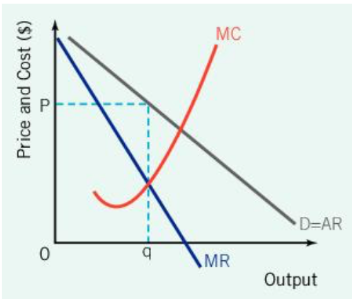
Monopoly, the Industry, & Market Power
The monopolist IS
the industry
Because the demand curve is downward sloping the monopolist can control price or level of output, but not both
This means that monopolies cannot charge what they want and still sell their product--they have to lower their price to sell more
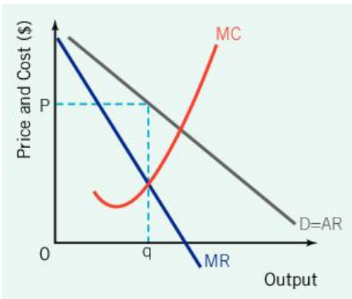
Monopoly, the Industry, & Market Power
The monopoly completely controls
industry output
This means they can restrict quantity to increase price
Level of market power is high
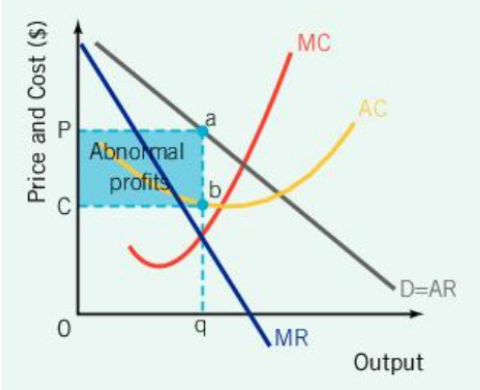
Monopoly: Profits and Losses
Abnormal Profits
If, in the short run, a monopoly is making abnormal profits, and they have effective barriers to entry that keep other firms out, then they can make
abnormal profits in the long run
This situation will continue as long as new firms cannot enter the industry
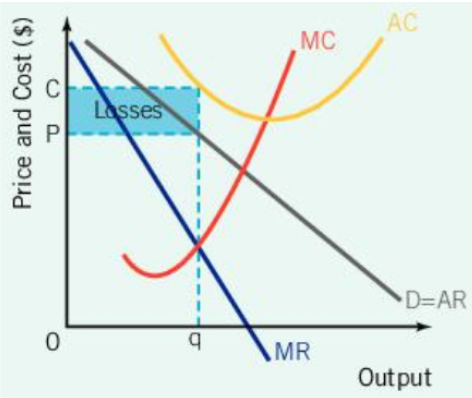
Monopoly: Profits and Losses
Losses
If the monopoly produces something for which there is little demand, they will face
losses
Firms then have two choices:
Make changes in order to achieve normal profit in the long run
Close the firm. Because the firm is the industry, the industry will cease to exist.
In this diagram, the firm cannot cover its costs in the long run: AC > AR
If nothing can be done to fix this situation, no firm will be willing to produce, so there will be no industry
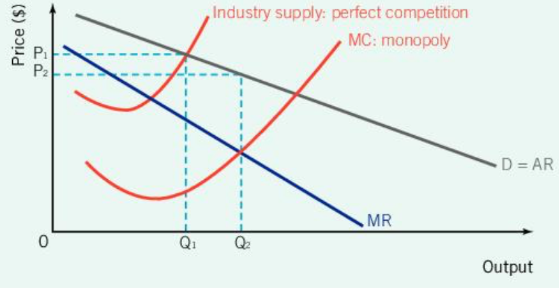
Monopoly vs. Perfect Competition
Advantages of Monopoly
Monopolies have
economies of scale, which allows higher product output and lower costs (and prices)
In the diagram, assume perfect competition the market equilibrium is where demand = supply (P1 & Q1)
If the firm is a monopoly and has economies of scale, the MC curve will be much lower. The monopoly maximizes profits at MC = MR, thus leading to lower costs and prices and greater output than the industry supply (perfect competition, P2 & Q 2).
I.e., monopolies produce lower prices and greater output than PC because of economies of scale
Monopoly vs. Perfect Competition
Advantages of Monopoly
dynamic efficiency
investment of profits into research & development or innovation
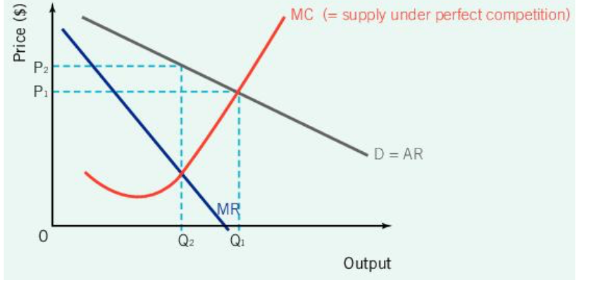
Monopoly vs. Perfect Competition
Disadvantages of Monopoly
Monopolies are neither
productively nor allocatively efficient
They can exercise anti-competitive behavior to keep their monopoly power
If not significant economies of scale, they can charge a higher price for a lower level of output
In the diagram, assume there are no differences in cost for a monopoly and the perfectly competitive market
Because the monopoly maximizes profits and therefore produces at MC = MR, costs are higher and output is lower (P2 & Q 2) than would be in perfect competition (P1 & Q 1).
Oligopoly =
few firms dominate an industry

Oligopolies are measured by
concentration ratios (CRx), which show the percentage of market share held by x firms
Example: In the US malt beverage industry, there are 160 firms and the CR4 is 90%, meaning the four largest firms produce 90% of the industry’s output--a high concentration of market power. In the frozen seafood industry, which has 600 firms, the CR4 is 19%--a low concentration of market power.
Therefore, the malt beverage industry is an oligopoly, while the frozen seafood industry is in monopolistic competition
oligopolies can produce
nearly identical products (petrol), highly differentiated products (motor cars), or slightly differentiated products (shampoo)
Oligopolies have
Distinct barriers to entry, such as large-scale production or distinct branding
Oligopolies have a level of
interdependence: Actions of one firm can have major effects on the others
Oligopolies also have
Price rigidity